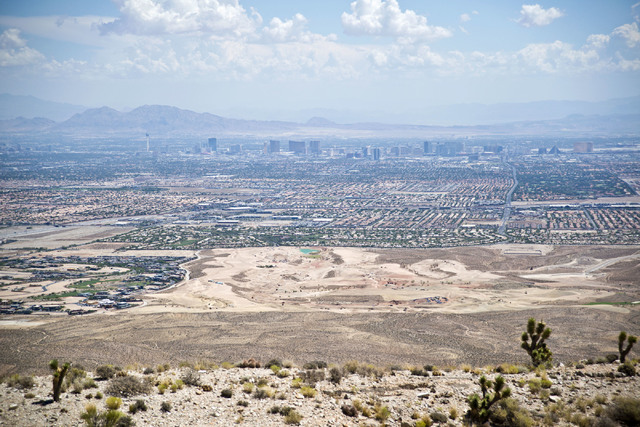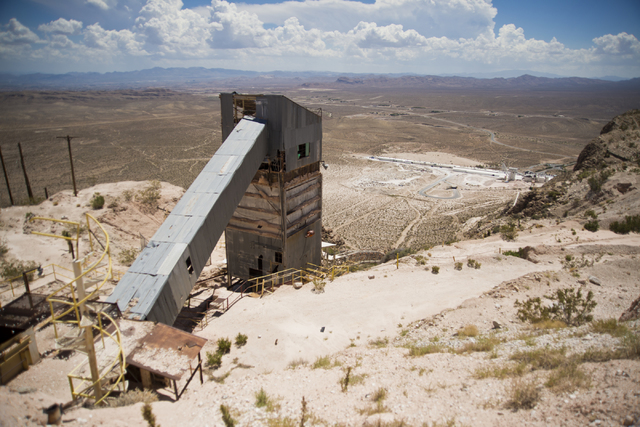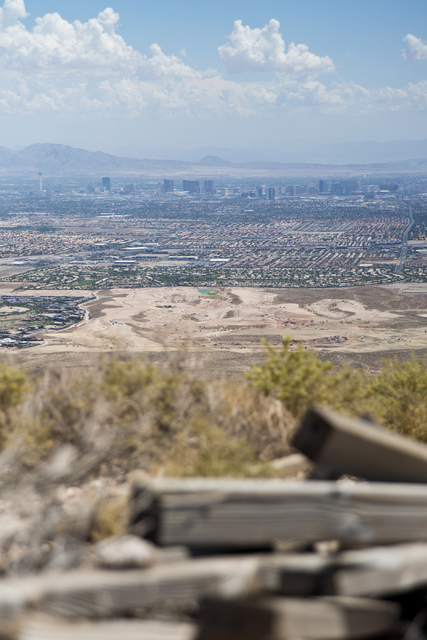Getting water to, from Blue Diamond Hill development won’t be cheap
The developer of Blue Diamond Hill can expect to spend tens of millions of dollars on infrastructure to provide water and sewer service to a proposed 5,025-home community, officials say.
“And that’s a conservative estimate,” said Bronson Mack, Las Vegas Valley Water District spokesman.
The steep cost is in large part because the development would be located on top of a bluff between Red Rock Canyon and Las Vegas, about 1,200 feet higher than anywhere else in Clark County’s existing water and sewer systems.
Mack estimated at least 6.5 miles of pipeline, three pumping stations and three reservoirs would be necessary to get water up the hill. More infrastructure will be needed to distribute it throughout the development.
A separate system of pipes will be needed to remove sewage, said Tom Minwegen, general manager for the Clark County Water Reclamation District.
“When you look at that topography and those elevation changes, I have nothing to compare it to,” Minwegen said. “I don’t know of anything that compares to that in our project history as far away from the existing community.”
Like all major projects in the county, the developer will pay the cost of installing the infrastructure. Taxpayers will pay for its upkeep.
ESTIMATED CONSUMPTION
The Blue Diamond Hill development is the brainchild of developer Jim Rhodes and mining company Gypsum Resources, which owns the roughly 2,000-acre site.
At full buildout, the master planned community could require moving millions of gallons of water up and down Blue Diamond Hill each day, according to estimates Gypsum Resources gave the county in late 2011.
On average, the community could need 7.1 million gallons of water from Lake Mead each day, according to the estimates. That number could double on days of peak demand.
“These numbers are likely higher than what their demand is actually going to be, but these are really good numbers for their planning purposes and determining their infrastructure needs,” Mack said.
Project planning consultant and spokesman Ron Krater added that the numbers Gypsum Resources submitted in 2011 were to give the county an idea of the community’s maximum possible water consumption. He anticipates the numbers will be updated to involve water-saving strategies.
“Water conservation will be a critical piece of this community,” he said. “We’re convinced that per capita we can reduce the overall water use on this property.”
IMPACT ON CURRENT SYSTEM
Southern Nevada uses about two-thirds of its available water supply to meet existing demands, Mack said. About 40 percent of what is used is returned to Lake Mead.
“The addition of 5,000 homes and their impact on Southern Nevada’s water supply will depend largely on the size of the homes and type of landscaping employed, as well as how the development plans to reuse treated wastewater,” Mack said. “Should this development move forward, its water use will not impact water deliveries to existing customers.”
After speaking with Gypsum Resources’ engineers last fall, the county’s wastewater experts expect a maximum outflow of about 4.8 million gallons per day.
“That’s more flow (of sewage) than the combined cities of Boulder City and Mesquite are treating today,” Minwegen said.
No timeline has been set on when construction of homes would begin. County commissioners have not approved the proposed development, and the water infrastructure will have to be installed before any homebuilding takes place.
But Mack and Minwegen agreed that the county’s water and sewage systems are adequately prepared to absorb the extra flow. They noted that the development is planned to be completed in phases that Gypsum Resources expects will take 15 to 20 years.
“We don’t expect them to flip a switch and it changes overnight,” Minwegen said.
Contact Michael Scott Davidson at sdavidson@reviewjournal.com or 702-477-3861. Follow @davidsonlvrj on Twitter.
RELATED
Why all the controversy about Blue Diamond Hill? Here's the rundown
Controversial plan near Red Rock Canyon gets Clark County Commission OK to proceed

























